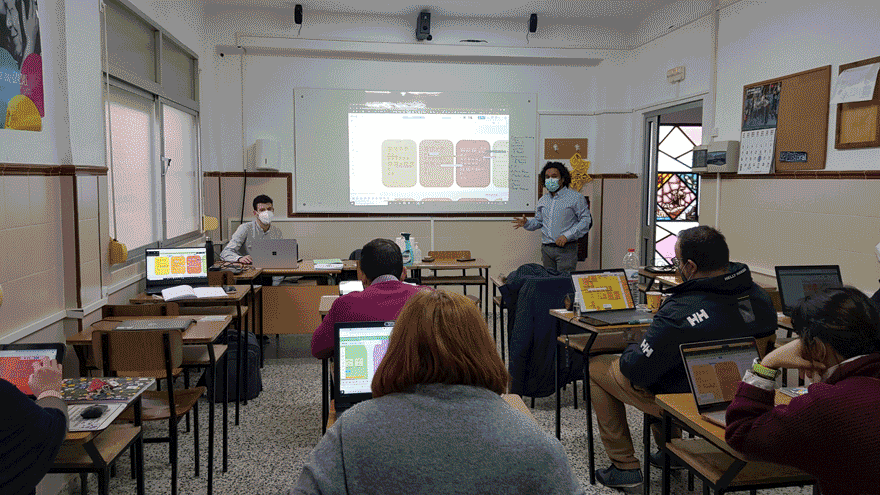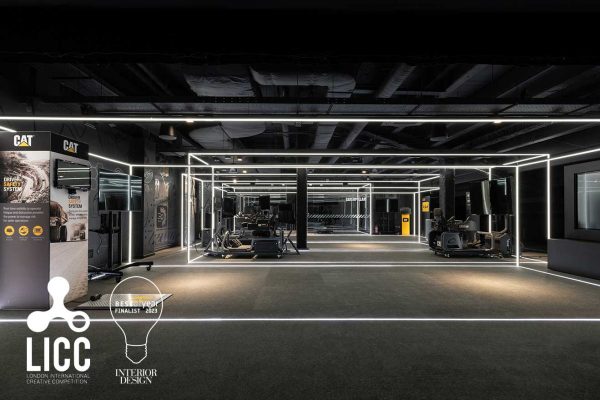
Colegio San José in Malaga decides to adapt its spaces to the new teaching methodologies that they are already putting into practice in their classrooms. A new learning design challenge arises, based on a thorough analysis of the school and its idiosyncrasies.
Due to the complexity that this entails in a large center, they decide to start by creating two cooperative classrooms. One of them for the fifth year of primary school and this one for the first year of secondary school.
starting point: new methodologies and design for learning
The San José school (Loyola Foundation) is a center divided into two buildings. In it, teaching is given from infant to professional training, passing through primary, secondary and high school.
In recent years, and with the experience of other foundation schools, the San José school has turned towards new teaching methodologies.

New methodologies pose a new challenge in the design of educational spaces.
These consist of implementing learning models based on cooperation, teamwork and the acquisition of knowledge through projects and problem solving. All this incorporating technology as a tool. A teaching model in which the master class and static disappear. The teacher becomes a guide championing the promotion of creativity and innovation from the center.
data collection
In a first phase, our objective was that the bases of the classroom design emerged from a cooperative model. For this reason, different collaborative sessions were organized with the center’s management and teaching team.
In them we learned about their wishes, their needs and we learned from the mistakes and successes of other schools, already spatially adapted to the new methodologies.

After finding out how the school wanted to be in the future, a roadmap of the spatial modifications to be made over time with all the spaces of the center was outlined.
In addition, the specific learning design needs of the co-operative classrooms in question were analysed.
As a result, the specific places where to locate the first two classrooms were determined.
In this first phase, a primary and a secondary classroom are designed. Below, you will be able to see the complete classroom design for the first year of secondary school.
design for cooperative learning
The starting space was made up of several traditional compartmentalised classrooms, where the first intervention was to convert them into a single, larger space.
A classroom design was proposed so that it would allow a flexible and adaptable space, in which the bulk of the storage would be on the perimeter, leaving the rest of the open space. An open space that allows different organizational solutions through the furniture and the mobile partition.
In cooperative learning, each activity or dynamic may involve a change of grouping of pupils, and therefore of furniture.

flexibility and learning
The tables are designed to generate diverse groupings. From individual use to groups in a circle or in a row of more and fewer students. They are stackable and can be removed to have a clear classroom.

The mobile partition manages to soundproof the classrooms by dividing the open space into two smaller rooms equipped exactly the same.
Each of them have sinks, a mobile digital screen, steps and a multipurpose room.
At the same time, the steps are also mobile and can be easily moved to be used as a meeting place or project presentations. In addition, its design incorporates holes for storage.


On the other hand, a magnetized finish is included for the paneled plinth of the secondary classroom, where students can hang work or any document they want to have in view.
In contrast to the open and mobile, a static space of support. The “fishbowl” space that, although separated, does not interrupt the perception of continuity due to its glass divisions.
A multipurpose room for possible oral tests, reinforcement classes, meetings with students and/or parents, mediation, personalized attention, auditions, etc.


Meanwhile, the teacher’s table disappears. This has a seat and a small support table that can be moved to any point in the classroom.
A model that turns the teacher into a guide who moves among his students. The classroom turns out to be a container of organizational possibilities where to learn in cooperation.
color and functionality: the rules of the game
In an open space whose use is intended for about sixty people, acoustic control becomes important.
The chip roof, the paneling of the walls, the insulation of the mobile partition and the great protagonist: the pavement, manage to absorb noise effectively.
The main protagonist of this learning design is the floor, where functionality and aesthetics come together. To this end, it was decided to promote the design of a floor that contrasts within a neutral container.
As an objective, to fuse design and practicality within a world of organizational possibilities.

As for the design, the use of color and basic geometric shapes take on a special role. Circumferences, straight lines, open curves and rectangles in a game of superimpositions that, although it may seem arbitrary at first, it is not.
Geometry and color are mixed to establish the “rules of the game” of this collaborative learning. The “playing field” works as a guide for the different grouping possibilities that the chosen furniture allows. Thus facilitating the work of teachers and students to organize, and streamlining classroom dynamics.


transparency in design for learning
Transparency between the classroom and the rest of the educational spaces becomes a premise of the project. To this end, the classrooms are closed off with glass partitions facing the centre’s galleries. The boundary of the classroom becomes blurred and the interior and exterior relationships merge.
One more way of transmitting to the centre the change of methodology and innovation in its facilities.


The entrances to the classrooms are marked with an accent colour, allowing students and visitors to situate themselves within the immensity of the centre.
A simple, colourful and functional game that brings dynamism to school routes.
In short, a design for learning that accompanies, through color and shapes, the energetic, fresh, dynamic and young environment always present in a school.
If you have found this project interesting, you can see the result of the primary cooperative classroom for this same school here.

